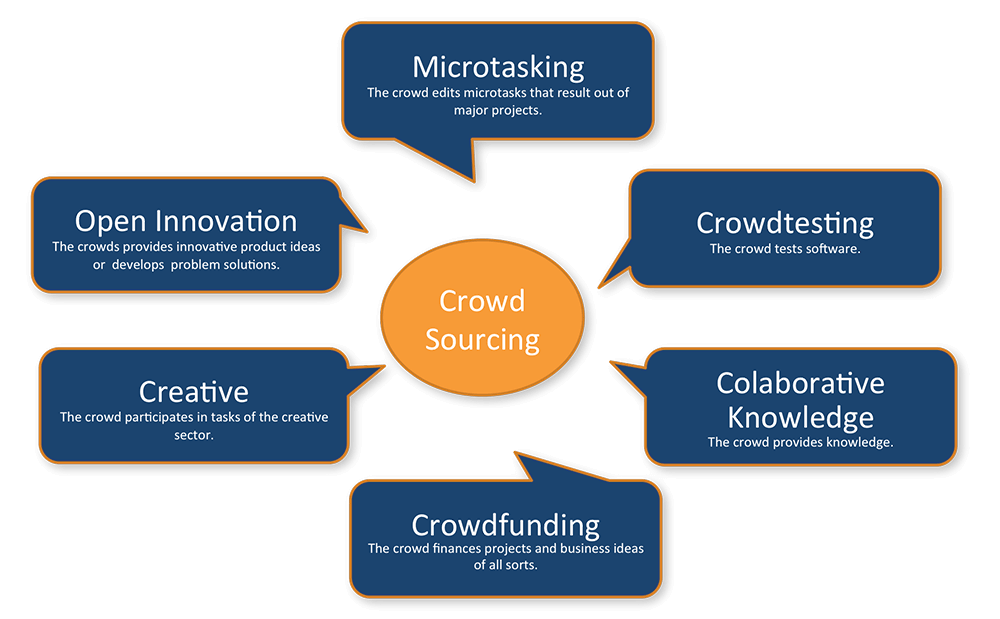
Crowdtesting
Crowdtesting is inviting and receiving feedback from a subset of your target audience to identify issues or problems with a product (often apps and websites). This gives you more visibility into how the product is being used and what challenges the audience may be having when interacting with your product (including technical bugs or usability issues with apps and websites).
The term crowdfunding is used when the crowd finances crowdsourcing projects or the development of new products. The crowd can sponsor projects via special platforms; in this case, special emphasis is placed on the non-material aspect. However, crowdfunding is also used as a means of preliminary financing in the United States. A provision is disbursed to the sponsors if the project is successful at the end.
In engagement and charity the term reveals that the crowd is expected to donate something. However, in this case the focus is on non-profit projects. Money donations are accepted but the organizations are just as happy to receive donations in kind such as food or clothing, as well as the involvement of voluntary helpers for various projects and events.
Collaborative Knowledge
The term collective knowledge describes the collection as well as filtering and organization of knowledge. In so-called group or collective intelligence many users put their knowledge at the disposal of the crowd. Wikipedia is an excellent example of this phenomenon. Likewise, the assessments or decisions of a large pool of different people can deliver equally good results as those of an expert in his field. So-called prognosis platforms make use of this principle.
Open Innovation
Open Innovation is a form of collaboration that aims to bring together diverse stakeholders and build new solutions for problems by expanding the traditional boundaries between business sectors. The most common type of open innovation is between firms and organizations that offer complementary capabilities.
Open innovation in crowdsourcing is the process of engaging diverse, external people in order to generate new ideas and solutions. Open innovation relies on a team or community approach so that different perspectives and knowledge can be shared.
Companies sometimes outsource their innovation process and strive, with the help of the crowd, to create new product ideas, produce, optimize and market products. This process can also be used to develop problem-solving solutions. High customer satisfaction is guaranteed thanks to the wide range of persons participating.
Creative Crowdsourcing Platforms
Creative and design crowdsourcing involves soliciting feedback from a large group of people to develop ideas, products or services. Creative crowdsourcing can include anything such as websites, apps, or even video games.
In addition, the creative crowd is also used to create graphic designs such as logos, brochures, advertising material, etc. Companies and private individuals offer creative tasks on numerous platforms; these jobs are more complex and better paid because they demand expert knowledge. As already mentioned before, these can include the creation of websites, banners or logos.
Microtasking
Microtasking is a type of crowdsourcing where individual tasks are assigned to small groups. Microtaskers can either be individuals or an organization that divides the work amongst its members. Microtasking is often used for tasks that require small individual steps, like writing a blog post or doing research.

When it comes to microjobbing or microtasking very small tasks, so-called microtasks, are offered to a large group of Internet users. In most of the cases these microtasks result out of a major project that has been divided into many similar subtasks.
The crowd is always a good choice whenever companies have to handle a larger number of tasks in a relatively short period of time. The use of the crowd makes a large number of workers available on demand without creating any overhead costs. Therefore, when demand is irregular, a company can make use of the manpower of thousands of workers on a flexible basis.
It goes without saying that the crowd is best used for tasks that are easily divided into individual microtasks and then reassembled to a convincing overall result after completion. In addition, the task that is being outsourced must not require any profound knowledge of your own product or company. This is essential to ensure that a sufficient number of qualified workers are available to implement the project in a short period of time and provide satisfactory results.








